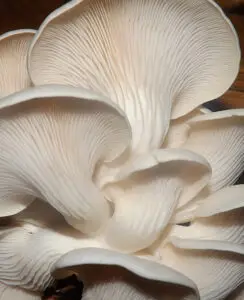
One of the most popular and widely cultivated edible mushrooms worldwide. With its delicate flavor and impressive nutritional profile, this mushroom has found a significant place in culinary and medicinal fields. Its ease of cultivation, especially using methods like liquid culture, has made it a favorite among mushroom growers, both commercially and for personal use.
Pleurotus ostreatus gets its common name, oyster mushroom, due to its shape and appearance. The caps are typically broad, fan-shaped, and resemble oyster shells. The color of the cap can range from white and gray to brown, depending on the strain and growing conditions. The gills of the oyster mushroom run down the length of the stem (or stipe), making it easily recognizable. Pleurotus ostreatus grows naturally on decaying wood, playing a critical ecological role as a decomposer by breaking down organic matter and enriching forest ecosystems.
In terms of nutritional value, oyster mushrooms are low in calories but rich in protein, fiber, vitamins (particularly B-vitamins), and minerals like iron and zinc. Additionally, oyster mushrooms contain compounds with medicinal properties, including antioxidants, anti-inflammatory agents, and even substances that can help lower cholesterol.
One of the most efficient and scalable methods for cultivating Pleurotus ostreatus is through liquid culture. Liquid culture involves growing mushroom mycelium in a nutrient-rich liquid solution, which helps produce strong, healthy mycelium more quickly than other methods, such as spore inoculation. Liquid culture is highly favored by growers because it reduces the time required for colonization and allows for more uniform growth, leading to higher success rates in mushroom production.
Using liquid culture to cultivate oyster mushrooms involves several steps:
The use of liquid culture for Pleurotus ostreatus offers several advantages over traditional methods:
Growing oyster mushrooms like Pleurotus ostreatus has many benefits, both for individual growers and for the environment. These mushrooms can be grown on a wide variety of substrates, including agricultural waste such as straw, coffee grounds, and sawdust. This versatility makes them a sustainable crop, as they help recycle organic material that would otherwise go to waste.
Additionally, oyster mushrooms are relatively easy to grow compared to other mushrooms, making them an excellent choice for beginner mycologists. Whether grown through traditional methods or via liquid culture, Pleurotus ostreatus requires minimal care once the substrate is inoculated. The mushrooms typically fruit within a few weeks, producing multiple harvests from a single batch of substrate.
Pleurotus ostreatus is highly prized in the culinary world for its mild, slightly sweet flavor and tender texture. It can be sautéed, grilled, or added to soups and stir-fries, making it a versatile ingredient in a wide variety of dishes. Oyster mushrooms also absorb flavors well, making them an excellent substitute for meat in vegetarian and vegan cooking.
In addition to its culinary appeal, Pleurotus ostreatus is gaining attention for its medicinal properties. The mushroom contains compounds with antioxidant, anti-inflammatory, and immunomodulatory effects, making it a promising candidate for supporting overall health. Research has also indicated that oyster mushrooms may help lower cholesterol levels, thanks to the presence of lovastatin, a compound that inhibits cholesterol production in the liver.
Pleurotus ostreatus, or the oyster mushroom, is a remarkable species with numerous benefits, from its ease of cultivation to its culinary versatility and medicinal potential. Growing this mushroom via liquid culture offers a highly efficient and scalable method, ideal for both novice growers and large-scale producers. As more people become interested in sustainable food sources and the health benefits of mushrooms, the popularity of Pleurotus ostreatus continues to rise. Whether you’re cultivating mushrooms for personal consumption or commercial purposes, this species is a rewarding choice that delivers on all fronts.
| Weight | 6.0 oz |
|---|---|
| Dimensions | 9 × 2 × 2 in |

Stay updated with our newsletter for exclusive offers, insights, and the latest in psilocybe cubensis research.

At The Spore Depot, we are dedicated to providing the highest quality psilocybe cubensis mushroom spores for research purposes. With an extensive selection of mushroom spores, our products meet the strictest quality standards, ensuring they are prepared under sterile conditions for optimal results. Whether you’re working with a spore syringe or creating a spore print for detailed analysis, we are committed to supporting your journey into the microscopic world.
Our exceptional contact customer service is here to assist you every step of the way, making sure your experience with psilocybe cubensis spores is both rewarding and insightful. At The Spore Depot, your satisfaction is our top priority as you explore the fascinating world of fungi.